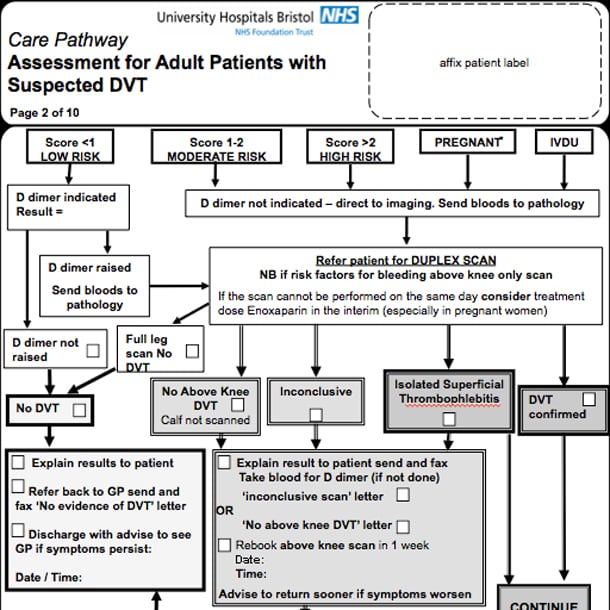Summary
The nurse-led thrombosis clinic at UH Bristol was set up in 2006 to manage the investigation and treatment of patients with a suspected DVT. The clinic now operates seven days a week and is based in the ambulatory care unit at the Bristol Royal Infirmary. Patients are offered an appointment on the day of referral to the service or within 24 hours if the referral is made late in the afternoon.
The number of patients now seen by this new service has increased dramatically, from 1,000 in 2008 to over 3,500 in 2013. By implementing rivaroxaban and reducing the workload on the team, the service has been able to evolve – increasing patient numbers, while also expanding the service without increasing staff numbers.
Challenge
The nurse-led Thrombosis Clinic at UH Bristol was set up in 2006 to manage the investigation and outpatient treatment of patients with a suspected DVT.
Prior to the development of the care pathway for adult patients with suspected DVT, all patients were assessed in the emergency department (ED), where they had to wait until a vascular scientist was available to perform a duplex scan.
If this confirmed a DVT, patients were discharged with outreach support or admitted under the care of the medical on take team. They then remained in hospital until their INR was stabilised.
This caused delays and possibility of breaches in the emergency department, along with unnecessary inpatient stays which were costly financially, physiologically and socially.
Objectives
The clinic is based in the Ambulatory Care Unit at the Bristol Royal Infirmary, operating seven days a week.
Patients are offered an appointment on the day of referral or within 24 hours if the referral is made late in the afternoon. Although no duplex scanning is available at the weekend, the clinic can assess patients and administer low molecular weight heparin. The nurses can also provide investigation and treatment for patients with a suspected pulmonary embolism (PE).
The overall aim of the service is to assess, investigate and treat patients in an outpatient setting, in as efficient a way as possible (to allow more patients to be seen) whilst providing expert, specialist care at all times.
Solution
In order to implement the desired changes, the team had to first revise its care pathway for suspected lower limb DVT to include Rivaroxaban. They then also implemented a new care pathway for patients with suspected upper limb DVT and low risk DVT which also included Rivaroxaban as a treatment option. All of these pathways went through the Trusts Clinical Guideline Committee.
Alongside PGDS for other anticoagulants used in the clinic the team also implmented a PGD for using Rivaroxaban. This was done in conjunction with the lead pharmacist.
Staff education was extremely important and Bayer helped out with literature and regular visits to talk about Rivaroxaban and its use. Senior staff in the clinic were on hand to act as a resource and ensure that all staff had relevant literature for themselves and that patient literature was also available.
Results
DVT patients are now seen within 24 hours of referral, and assessment, diagnosis and treatment all carried out in one area by specialist nurses. Patients get their scan results immediately and given an informed choise about treatment options. Telephone support and advice for both patients and healthcare professionals are available seven days a week.
The Thrombosis Clinic has seen an increasing number of patients referred by primary care. With 98 per cent of them given Rivaroxaban, the clinic’s workload has fallen dramatically. More patients can be seen, and specialist nurses can assess and treat not just DVT patients but also PE patients, without increasing staffing levels or compromising levels of care.
Learnings
Conversations with other clinics showed that some were ‘afraid’ to use new drugs, or did not feel that everyone embraces change. The Team found the use of Rivaroxaban a positive step as it has allowed them to implement other pathways. It also enabled them to become involved with inpatient care after diagnosis of PE, to ensure that patients receive appropriate information on their treatment options.
Patients are also not having to attend on multiple occassions for stabilistion of their anticoagulation which is a big positive for them. In addition, they now have more choice on their options with regards to treatment with anticoagulants.
Evaluation
The success of the project was measured by audits and patient questionnaires. It was also shown in patient numbers. These stood at 1,000 in 2008 and at over 3,500 in 2013. Services on offer have increased. These now include upper limb DVT, community-referred PE and Trust-wide inpatient PE.
The thrombosis service at UH Bristol has developed over the last few years, and is valued by the Trust as an example of excellence. Patient feedback has been encouraged, and has been found to be positive with regards to the care they have received.
The clinic has evolved and ensures that practice is evidence-based with regards to the patient pathway.





